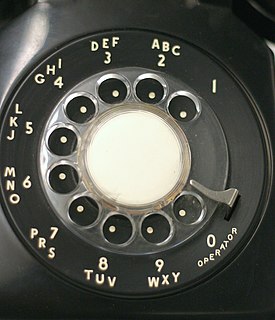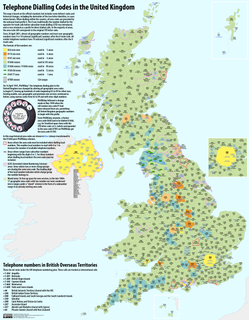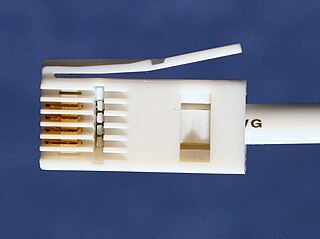Related Research Articles
An automatic number announcement circuit (ANAC) is a component of a central office of a telephone company that provides a service to installation and service technicians to determine the telephone number of a telephone line. The facility has a telephone number that may be called to listen to an automatic announcement that includes the caller's telephone number. The ANAC facility is useful primarily during the installation of landline telephones to quickly identify one of multiple wire pairs in a bundle or at a termination point.

A rotary dial is a component of a telephone or a telephone switchboard that implements a signaling technology in telecommunications known as pulse dialing. It is used when initiating a telephone call to transmit the destination telephone number to a telephone exchange.

The North American Numbering Plan (NANP) is a telephone numbering plan for twenty-five regions in twenty countries, primarily in North America and the Caribbean. This group is historically known as World Zone 1 and has the international calling code 1. Some North American countries, most notably Mexico, do not participate in the NANP.
Automatic number identification (ANI) is a feature of a telecommunications network for automatically determining the origination telephone number on toll calls for billing purposes. Automatic number identification was originally created by the American Telephone and Telegraph Company (AT&T) for long distance service in the Bell System, eliminating the need for telephone operators to manually record calls.
A toll-free telephone number or freephone number is a telephone number that is billed for all arriving calls. For the calling party, a call to a toll-free number from a landline is free of charge. A toll-free number is identified by a dialing prefix similar to a geographic area code. The specific service access numbers vary by country.
A ringback number is a telephone number for a telephone line that automatically calls the line that the call was placed from, after the caller has hung up. The typical use of this facility is by telephone company technicians for testing a new installation or for trouble-shooting.
The telephone number prefix 555 is a central office code in the North American Numbering Plan, used as the leading part of a group of 10,000 telephone numbers, 555-XXXX, in each numbering plan area (NPA). It has traditionally been used only for the provision of directory assistance, when dialing -555-1212.
A telephone numbering plan is a type of numbering scheme used in telecommunication to assign telephone numbers to subscriber telephones or other telephony endpoints. Telephone numbers are the addresses of participants in a telephone network, reachable by a system of destination code routing. Telephone numbering plans are defined in each of the administrative regions of the public switched telephone network (PSTN) and in private telephone networks.

Telephone numbers in the United Kingdom are administered by the Office of Communications (Ofcom). For this purpose, Ofcom established a telephone numbering plan, known as the National Telephone Numbering Plan, which is the system for assigning telephone numbers to subscriber stations.
The Australian telephone numbering plan describes the allocation of phone numbers in Australia. It has changed many times, the most recent major reorganisation by the Australian Communications & Media Authority taking place between 1994 and 1998.

Numbers on the Irish telephone numbering plan are regulated and assigned to operators by ComReg.
Widespread UK telephone code misconceptions, in particular brought on by the Big Number Change in 2000, have been reported by regulator Ofcom since publication of a report it commissioned in 2004.

The dialling plan for mobile networks and new landline operators is closed; all subscriber numbers must be dialled in full. For landline numbers starting with 02, the dialling plan used to be open; the trunk digit and area code could be omitted if the caller was in the same area code as the callee. However, starting May 3, 2008, all landline numbers must be dialled in full.
A feature group, in North American telephone industry jargon, is most commonly used to designate various standard means of access by callers to competitive long-distance services. They defined switching arrangements from local exchange carriers central offices to interexchange carriers. These arrangements were described in an official tariff of the National Exchange Carrier Association, filed with the Federal Communications Commission (FCC).
1-5-7-1 is the name of a family of calling features in the United Kingdom, for residential and business telephone lines and for mobile telephones, that are provided by BT Group and several other telephone service providers. The family is named after the telephone number 1571, the special service number that is used to access it. Call Minder is the name of BT's highest level of 1571 service.

British telephone sockets were introduced in their current plug and socket form on 19 November 1981 by British Telecom to allow subscribers to connect their own telephones. The connectors are specified in British Standard BS 6312. Electrical characteristics of the telephone interface are specified by individual network operators, e.g. in British Telecom's SIN 351. Electrical characteristics required of British telephones used to be specified in BS 6305.

A telephone number is a sequence of digits assigned to a landline telephone subscriber station connected to a telephone line or to a wireless electronic telephony device, such as a radio telephone or a mobile telephone, or to other devices for data transmission via the public switched telephone network (PSTN) or other public and private networks.
Ranges for fictitious telephone numbers are common in most telephone numbering plans. One of the main reasons these ranges exist is to avoid accidentally using real phone numbers in movies and television programs because of viewers frequently calling the numbers used. In North America, the area served by the North American Numbering Plan (NANPA) system of area codes, fictitious telephone numbers are usually of the form (XXX) 555-xxxx. The use of 555 numbers in fiction, however, led a desire to assign some of them in the real world, and some of them are no longer suitable for use in fiction. Other areas have different fictitious telephone numbers.

A telephone exchange, telephone switch, or central office is a telecommunications system used in the public switched telephone network (PSTN) or in large enterprises. It interconnects telephone subscriber lines or virtual circuits of digital systems to establish telephone calls between subscribers.
Telephone numbers in the United Kingdom have a flexible structure that reflects their historical demands, starting from many independent companies through a nationalised near-monopoly, to a system that supports many different services, including cellular phones, which were not envisaged when the system was first built. Numbers evolved in a piecemeal fashion, with numbers initially allocated on an exchange-by-exchange basis for calls connected by manual operators. Subscriber numbers reflected demand in each area, with single digit telephone numbers in very rural areas and longer numbers in cities.
References
- ↑ "TUCoPS :: Phreaking Caller ID :: anac.txt". www.artofhacking.com. Retrieved 2020-02-13.
- ↑ "Loop Lines". home.ptd.net. Retrieved 2020-02-13.
- ↑ "BT line test facility". Archived from the original on 2013-11-11. Retrieved 2013-11-11.
- ↑ "Archived copy" (PDF). Archived from the original (PDF) on 2013-09-02. Retrieved 2013-11-11.
{{cite web}}: CS1 maint: archived copy as title (link) - ↑ Plant test exchange prefixes appear in the list of CO Code assignments (per area code) at http://nanpa.com (US) and http://cnac.ca (Canada) but the individual numbers are unpublished by design, as they're intended for installers only.